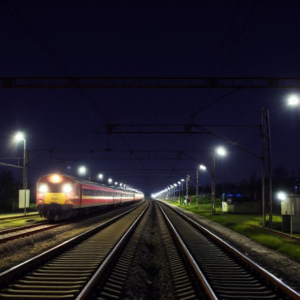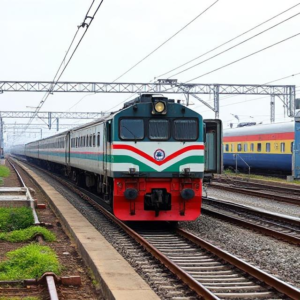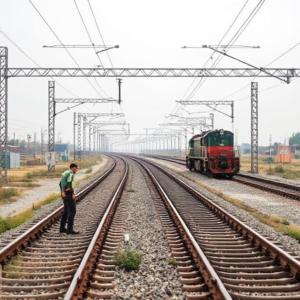What Is Cross-Border Train Communication?
Cross-Border Train Communication refers to the system that allows trains to communicate and share important information when they travel across different countries. Since each country has its own railway systems, signals, and regulations, it’s essential for trains to be able to “talk” to each other and to different systems as they cross borders to ensure safe, smooth, and efficient travel.
Imagine you are traveling from one country to another on a train. The train might need to adjust its speed, follow new signals, or change its route based on the rules of the new country it enters. For this to happen, the train must be able to receive and send information across the border to make those changes safely and on time.

Why is Cross-Border Communication Important?
- Safety: Different countries have different train regulations and signal systems. The train needs to be able to understand and follow new signals and rules when crossing borders.
- Efficiency: To avoid delays and ensure smooth travel, the train must be able to communicate with railway systems across borders.
- Coordination: When trains cross borders, they often need to work with railway companies in both countries. Good communication helps coordinate schedules, customs, and border control checks.
Challenges in Cross-Border Train Communication
- Different Systems: Each country might use different train signaling, safety systems, or communication technologies. This can make it hard for the train to understand or follow new rules once it crosses the border.
- Language Barriers: The language spoken in one country might be different from the language in the next country, which can make communication between railway operators more difficult.
- Technical Differences: Some countries use different technologies for controlling trains. The signals, safety systems, and communication equipment might not always be compatible.
How Does Cross-Border Communication Work?
To make cross-border train travel safe and smooth, several key technologies and systems are used to ensure that communication between countries’ railway networks happens seamlessly.
1. European Train Control System (ETCS)
- What it is: ETCS is a standardized train control system used in Europe to allow trains to communicate with different countries’ railway systems. It makes sure that trains follow safety regulations, even when crossing borders.
- How it works: ETCS is a system installed on the train and along the tracks. It allows the train to “speak” with the signaling system in the country it is traveling through, making sure the train stays safe by adjusting its speed and direction based on the signals and rules of the current country.
- Why it’s important: This system ensures that trains from different countries can operate safely across borders without requiring completely new equipment or systems when crossing into a different country.
2. Global System for Mobile Communications – Railway (GSM-R)
- What it is: GSM-R is a special mobile communication system designed for trains. It’s like a dedicated “phone network” for trains that allows them to communicate with each other and the railway network.
- How it works: The system uses mobile radio signals to send and receive information about the train’s location, speed, and other important details. It also lets operators contact the train if there’s an issue or a safety concern.
- Why it’s important: GSM-R helps train operators stay in constant communication with each other, even when the train crosses into a new country. This ensures that the train is always monitored, and any issues can be addressed quickly.
3. Interoperability Standards
- What it is: Interoperability refers to the ability of different countries’ railway systems to work together smoothly. Countries agree on certain rules, standards, and technologies to make sure their rail systems are compatible.
- How it works: These standards ensure that trains can use the same communication systems, follow the same signaling rules, and follow safety protocols across borders. For example, if a train crosses from one country to another, it might switch to the local signaling system, but it will still communicate through the same language and systems as before.
- Why it’s important: It ensures that trains can move smoothly from one country to the next without encountering technical or communication problems.
4. Train Data Exchange Systems
- What it is: Train data exchange systems are used to share information between different countries’ railway networks. This system helps manage schedules, freight, and any border control checks.
- How it works: The train’s data, such as its location, schedule, and cargo, can be sent to operators in other countries so they know what to expect. This also helps customs or border control know when to inspect the train or its passengers.
- Why it’s important: This data-sharing keeps everything coordinated and helps avoid delays when the train crosses borders.
How It Works in Practice:
Let’s take an example of a train traveling from Germany to France:
- Before Crossing the Border: The train will use the ETCS system to communicate with the German railway system. This ensures the train follows all of Germany’s speed limits, signals, and safety rules.
- Approaching the Border: As the train nears the border, it begins using GSM-R to send data about its location, speed, and status to both the German and French railway operators.
- Crossing into France: When the train enters France, the ETCS adjusts to the French signaling system. The train automatically switches to the French system without any need for manual intervention, ensuring safety.
- Coordination: The French system gets updated information about the train through the data exchange system. The train may also be inspected by border control or customs, but the communication systems help make this process fast and easy.
Benefits of Cross-Border Train Communication:
- Increased Safety: Real-time communication ensures the train follows safety rules in each country it travels through, reducing the risk of accidents or mistakes.
- Faster Travel: Efficient communication and coordination between countries help reduce delays, as the train doesn’t have to stop or wait for manual checks when crossing borders.
- Improved Efficiency: By sharing data, such as schedules and customs information, the process of crossing borders is streamlined, allowing for smooth transitions between different countries’ railway systems.
- Enhanced Passenger Experience: Passengers can travel more easily between countries without worrying about changing trains or delays, making cross-border travel more convenient.
Conclusion:
Cross-Border Train Communication is all about ensuring that trains can travel smoothly and safely between different countries. By using systems like ETCS for train control, GSM-R for communication, and interoperability standards for coordination, trains can “talk” to different countries’ systems, share important data, and follow safety rules. This makes cross-border train travel faster, safer, and more efficient, benefiting passengers and railway operators alike.
Keywords: Railway Data Analytics, Railway











